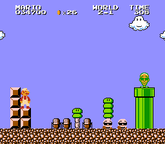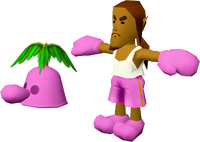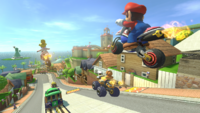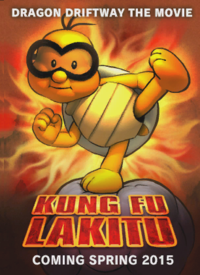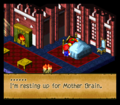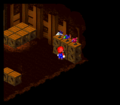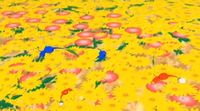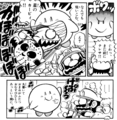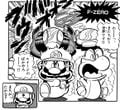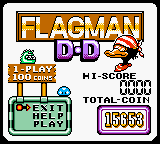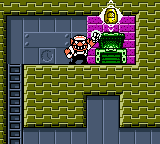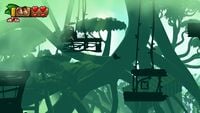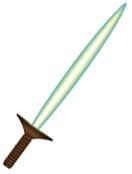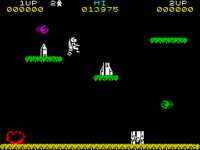List of references in the Super Mario franchise
It has been requested that this article be rewritten and expanded to include more information. Reason: include references in comics; many of these references are unsourced and seem to be based on pure speculation (tagged on May 10, 2017)
- This article is about references made within the Super Mario franchise to outside media and real life. For references to the Super Mario franchise made by external sources, see Lists of references.
The following is a list of references to works and elements of the media, other assets of popular culture, and real-life celebrities and historical persons that have appeared in the Super Mario franchise and its partner franchises. Note that references to other Super Mario media are not included here, nor are references in crossovers referring to the original series' source material. Historical or geographical references are also not included.
Arcade games[edit]
Donkey Kong[edit]
- The tune that plays when Donkey Kong is climbing to the top of the construction site is a snippet of the theme song of Dragnet.
- The 25m Theme is a snippet of the bassline of "The Ballad of John and Yoko" by English rock band the Beatles.
- The "How High Can You Get?" jingle is similar to the jingle upon completing the third level in the Nintendo arcade game Sky Skipper. Both games were developed and released simultaneously by Nintendo Research & Development 1.
Donkey Kong Jr.[edit]
- The jingle that plays when starting a new game in the arcade version of the game is a snippet of "Toccata and Fugue" by Johann Sebastian Bach.
- The music when Mario goes to his hideout by using his helicopter is "Infernal Galop" by Jacques Offenbach, also known as the theme commonly associated with the can-can.
Mario Bros.[edit]
- The music that plays when the player begins Phase 1 is the opening eighteen notes of Mozart's Eine kleine Nachtmusik.
- In the Atari commercial, the song that plays is a parody of the Car 54, Where Are You? intro.
- The Japan-only re-release of this game, Mario Bros. have returned, features advertisements between its levels, either for other Super Mario games (such as Super Mario Bros. 3) or for the re-release's sponsor, the Nagatanien food company.
Super Mario series[edit]
Super Mario Bros.[edit]
- The Beanstalk that Mario uses to climb up to Coin Heaven is a reference to the English folktale Jack and the Beanstalk.
- Bowser's initial design was based on the ox king antagonist from Toei Animation's Journey to the West (renamed Alakazam the Great for its English release).
- The pause sound effect is recycled from Devil World.
All Night Nippon: Super Mario Bros.[edit]
An officially licensed retool of Super Mario Bros., many of the game's graphics have been altered or completely changed to feature references to All Night Nippon:
- The faces on the Goombas and the Piranha Plants are based on Sunplaza Nakano, one of the show's DJ's.
- Starmen are replaced with Hiranya, a symbol popularized by the Japanese radio show Young Paradise.
- The symbol that appears on the flag raised when Mario enters the end-of-level fortress and the axe at the end of each of the castle levels is replaced with the logo for Fuji Television.
- The mushroom retainers saved at the end of each castle have been replaced with the show's hosts. Respectively, they are: Miyuki Nakajima (World 1), Takaaki Ishibashi (World 2), Noritake Kinashi (World 3), Kyōko Koizumi (World 4), Takeshi Kitano (World 5), Daisuke Matsuno (World 6), and Hideyuki Nakayama (World 7).
Super Mario Bros. Special[edit]
- The item Hachisuke is based on the bee from the Hudson Soft logo.
Super Mario Bros.: The Lost Levels[edit]
- The skidding sound (which would later be used in Super Mario Bros. 3) sounds similar to the tire screeching sound from the Famicom game F1 Race.
Super Mario Bros. 2[edit]
- The sound effect of Birdo spitting an egg is taken from the sound effect that plays when a magical projectile is fired by the Magical Rod item or the Wizzrobe enemy in The Legend of Zelda.
Super Mario Bros. 3[edit]
- The "Magic Whistle" item is the Recorder from The Legend of Zelda; it summons a whirlwind to warp the player character to another location and plays the same tune when used, which has become a reoccurring melody in the original series. Also, the music that plays in Water Land is very similar to the Fairy Fountain theme.
- The island on which the castle of Water Land is located is designed after Japan; the castle itself is also placed in the same location that Kyoto would be, the city in which Nintendo's headquarters is located.
- Super Mario Advance 4: Super Mario Bros. 3 adds to this reference by adding Sado Island.
- In the Family Computer and Nintendo Entertainment System versions, the sound effect for the Raccoon Mario transformation (as well as the Tanooki Mario transformation) is taken directly from the sound used when certain enemies appear in The Mysterious Murasame Castle.
- Excluding Larry Koopa,[1] the Koopalings are named after rock-and-roll musicians or classical music composers:
- Morton Koopa Jr. is named after former country/western singer-turned talk show host Morton Downey Jr., since he "looked like a loudmouth."[1]
- Wendy O. Koopa is named after Wendy O. Williams, lead singer of American rock band The Plasmatics.[1]
- Iggy Koopa is named after Iggy Pop, lead singer of American rock band The Stooges.[1]
- Roy Koopa is named after early American rock musician Roy Orbison, since they both wore glasses.[1]
- Lemmy Koopa is named after Lemmy Klimister, late lead singer of British rock band Motorhead.[1]
- Ludwig von Koopa is named after composer Ludwig van Beethoven, due to their hairstyle.[1]
Super Mario Land[edit]
- The theme that plays for the Super Star in this game is taken from a portion of Offenbach's "Infernal Galop".
- The background music for ground levels in Chai Kingdom opens with the Oriental riff, a passage popularly used in western music to represent East Asia, especially imperial China.
Super Mario World[edit]
- Reznor is named after Trent Reznor, the founder of industrial rock band Nine Inch Nails.
- Rip Van Fish is named after Rip van Winkle, the main character of the story with the same name who fell asleep for twenty years.
- The sound effect used for when a Yoshi Egg hatches sounds similar to when Tamagon's egg hatches in the NES game Devil World.
Super Mario Land 2: 6 Golden Coins[edit]
- The fourth level of the Mario Zone features LEGO-like surfaces. At one point in the level, it is revealed that these are N&B Blocks, a toy manufactured by Nintendo in the 1960s to compete with the popularity of LEGO.
- The second level of the Turtle Zone has urchin-like enemies, Unibo, that strongly resemble Gordos from the Kirby series.
- The Masked Ghoul enemy in the Pumpkin Zone is a reference to Jason Voorhees from the movie series Friday the 13th.
- The Three Little Pigheads are a reference to the fairy tale "The Three Little Pigs". They also emerge from houses made of straw, sticks, and bricks, respectively, which reference the houses the Big Bad Wolf attempts to blow down.
Super Mario 64[edit]
- Whomps are based on Nurikabe, which in Japanese folklore is a living wall that gets in the way of travelers.
- Bowser's roars and growls used in this and other games are stock sound effects that were previously used for King Kong and other movie monsters throughout several decades.
Super Mario Sunshine[edit]
- If the game is hacked to remove Il Piantissimo's mask, he has the same face of the Running Man and the postman of Termina, from The Legend of Zelda: Ocarina of Time and The Legend of Zelda: Majora's Mask, respectively, only with darker skin.
- The second Shine Sprite mission of Ricco Harbor, Blooper Surfing Safari, is named after the The Beach Boys' song, "Surfin' Safari".
- During the third mission of Ricco Harbor, The Caged Shine Sprite, a Pianta says, "Hey, it's just like in the movies! You know the scene? It's where something's on the manhole, and they can't get it open." This may be a reference to the 1948 film He Walked by Night.
- Phantamanta is a reference to the ending of the horror novel The Shining: "For a moment it assumed the shape of a huge, obscene manta, and then the wind seemed to catch it, to tear it and shred it like old dark paper. It fragmented, was caught in a whirling eddy of smoke, and a moment later it was gone as if it had never been."
Super Mario 64 DS[edit]
- In the minigame Loves Me...?, if the player wins three times in a row, an arrangement of the tune that plays when Link uses the Recorder in The Legend of Zelda can be heard.
Super Mario Galaxy[edit]
- Roctos, Octoguys, and Octoombas resemble and behave in a similar way to Deku Scrubs and Octoroks from The Legend of Zelda.
- Star Bits are based upon a Japanese candy called konpeitō.
- In the Rolling Gizmo Galaxy, a hidden bunch of Star Bits formed in a shape similar to a Rupee from The Legend of Zelda can be seen.
- The battle against Megaleg is based upon the Ganon boss fight that was originally planned for The Legend of Zelda: Ocarina of Time.
- The rockets in the Space Junk Galaxy and the Ghostly Galaxy closely resemble Captain Olimar's ship.
- The last planet visited in the Buoy Base Galaxy (when it opens up) is based on gashapon capsules, which are transparent containers that contain small toys, dispensed from vending machines. As stated by the Prima Guide, it also bears a superficial resemblance to a Poké Ball.
- The Topman Tribe enemies heavily resemble the Beyblade toys, which are in turn based on beigoma; Japanese spinning tops made to fight each other.
- The name of the Sea Slide Galaxy mission "Faster Than a Speeding Penguin" is taken from the first part of Superman's catchphrase, namely "faster than a speeding bullet".
Super Mario Galaxy 2[edit]
- The gold Gearmo in Boulder Bowl Galaxy will ask Mario for a Goomba, and the silver Gearmo in Space Storm Galaxy will ask for a Topman. After being given what they ask for, they will hold it up in the air exactly like Link does when he gets an item in The Legend of Zelda.
Super Mario 3D Land[edit]
- World 5-2 is based on the dungeons in The Legend of Zelda, in honor of the series' 25th anniversary. Additionally, when Mario or Luigi opens the area that contains the second Star Medal, the "found a secret" theme as heard in The Legend of Zelda: Ocarina of Time is heard.
New Super Mario Bros. 2[edit]
- The Reznor's roar bears a strong resemblance to Godzilla's roar.
- Dry Bones' dance during vocal riffs in the Tower theme resembles some of the choreography in Michael Jackson's Thriller music video.
New Super Mario Bros. U[edit]
- In Soda Jungle-4, Painted Swampland, the level's aesthetic appearance is an homage to Vincent van Gogh's The Starry Night. This also applies to Superstar Road-5, Spinning Platforms of Doom, and their equivalent levels in New Super Luigi U, Painted Pipeworks and Under Construction, respectively.
Super Mario 3D World[edit]
- When Bowser captures the Sprixie Princess at the start of the game, he does so by trapping her in a bottle, which is the same way Link catches fairies in The Legend of Zelda.
- In Rainbow Run, a secret area similar to the one from Bob-ombs Below appears, except this time the blocks make up an 8-bit sprite of Link. After stepping on every block, the "Item Get" tune from The Legend of Zelda: Ocarina of Time will play, followed by a remix of the series' theme.
Super Mario Maker[edit]
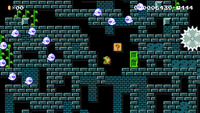
- Many of the Costume Mario costumes are based on characters from other non-Super Mario franchises.
- In the Super Mario World-themed underwater course, the sprite of a Spike Trap is replaced with a Sea Urchin from The Legend of Zelda: Link's Awakening, which in turn appears similar to the Gordos of the Kirby series. However, unlike the sequel, placing one still announces it as a Spike Trap instead of a Sea Urchin.
Super Mario Odyssey[edit]
- Many locations visited in the game are inspired by real world locations, such as Tostarena (based on Mexico), New Donk City (based on New York City, US), Shiveria (based on Siberia, Russia), and several regions in the Luncheon Kingdom (based on Pompeii, Italy).
- Wooded Kingdom is very similar to the setting of the 1972 science fiction film Silent Running, which takes place in a giant greenhouse maintained by robots that also happen to resemble the Steam Gardeners.
Super Mario Maker 2[edit]
- Takamaru and multiple ninjas from The Mysterious Murasame Castle appear as part of the animation for the "Ninja Attack!" sound effect that plays a sped-up version of the game's main theme.
- The course creators Agent 1, Agent 2, Celebrity MC, and Celebrity DJ are respectively based on Callie, Marie, Pearl, and Marina from the Splatoon series.
- A 16-bit arrangement of part of the music for the Famicom Disk Writer plays during the balloon Toad House minigame in a Super World, which is inspired by an animation in the Disk Writer where a bald man pumps air into an inflatable replica of himself.[2]
- A 16-bit arrangement of the title theme from the Baseball plays when starting the baseball Toad House minigame in a Super World. The minigame also uses sound effects from the game.
Super Mario 3D World + Bowser's Fury[edit]
- In a video posted on the Play Nintendo YouTube channel which presents ways to defeat Goombas in the game, the narrator freeze-frames the footage while a Goomba is lured into a pit and comments that "it was at this moment the Goomba knew… they messed up",[3] using a differently-worded version of the popular catchphrase "It was at this moment he knew… he fucked up".
Mario Teaches Typing series[edit]
- The games' Mario in Real Time segments have several references in them:
- When Mario says "Look, I'm a video game.", he moves his head in a similar fashion to the ball in Pong.
- When Mario says "Sorry; that's-a hard for you, but easy for me. You know why?", he sings part of the chorus for "I Ain't Got Nobody".
- Mario, offscreen, shouts "I've fallen, and I can't get up!". He then finishes by saying "That is my impression of American advertising!", referencing the fact that said line originated from LifeCall, an American company.
- When Mario says "Can I sing a song for you?", he sings the chorus of "That's Amore", then sings a variation of it with an eel-related pun.
Mario Kart series[edit]
Super Mario Kart[edit]
- The jingle used when the player comes in 5th-8th place at the end of a race samples the song "Entrance of the Gladiators" composed by Julius Fučík.
Mario Kart DS[edit]
- The Power Flower kart's Spanish name features a flower-themed pun on the Spanish name for a Volkswagen Beetle.[4][timestamp needed]
- The Zipper kart's Spanish name is a portmanteau of Waluigi, the character driving said kart, and motorcycle brand Harley-Davidson.
- The Wildlife kart's German name references vehicle brand Jeep.
Mario Kart Wii[edit]
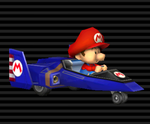
- The Blue Falcon kart is a reference to the vehicle of the same name in the F-Zero series, driven by Captain Falcon.
Mario Kart 8[edit]
- Two crossover downloadable content packs released post-launch: The Legend of Zelda × Mario Kart 8 (pack one) and Animal Crossing × Mario Kart 8 (pack two).
- Link appears as a playable character in pack one, while the Villager and Isabelle from the Animal Crossing series appear in pack two.
- Hyrule Circuit (based on The Legend of Zelda series), Mute City (from the F-Zero series) and Excitebike Arena (based on Excitebike) appear in pack one, while Animal Crossing (based on the Animal Crossing series), and Big Blue (also from F-Zero) appear in pack two, with each track featuring a cover theme from their respective series.
- The Blue Falcon returns as a vehicle in pack one. Also included in pack one are the Master Cycle, Triforce Tires, and Hylian Kite, all themed after The Legend of Zelda. Pack two includes the Streetle, City Tripper, Leaf Tires, and Paper Glider, all based on Animal Crossing.
- On Mute City and Big Blue, the countdown and results music are those of the F-Zero series rather than those used on other courses. On Big Blue, reaching the final section of the course causes the announcer from F-Zero X to say, "Yeah! The final lap!" In addition, Animal Crossing uses the music played in The Roost for its results theme.
- The Mercedes-Benz GLA, W 25 Silver Arrow, and 300 SL Roadster appear as downloadable vehicles, and the GLA's tires also appear as a set of tires.
- In Toad Harbor, a statue of Princess Peach similar in appearance to the Statue of Liberty can be seen. Toad Harbor also has some similarities to the city of San Francisco, California.
- As of update 3.0, by scanning a compatible amiibo into the game, the player can receive Mii costumes based upon various Nintendo characters, including Kirby, Captain Falcon, Link, and Fox.
- A spotlight in 3DS Neo Bowser City displays the course's version of Bowser's emblem in a similar fashion to the Bat-Signal.
- In GBA Ribbon Road, there is a poster that parodies Kung Fu Panda called "Kung Fu Lakitu".
Mario Kart 8 Deluxe[edit]
- Urchin Underpass and Inklings from Splatoon appear in the game, as a battle course and playable characters respectively.
Role-playing games[edit]
Super Mario RPG: Legend of the Seven Stars[edit]
- Link can be found sleeping in the Rose Town inn after beating Bowyer in the Forest Maze. Talking to him plays the series' classic discovery jingle.
- Samus can be found sleeping in the guest bed of the Mushroom Castle after beating Speardovich, and before going to Land's End. When spoken to, she says she is "resting up for Mother Brain", a recurring villain in the Metroid series.
- A Samus action figure and a remote-controlled car resembling the F-Type from Stunt Race FX can be found in a toy box in Booster Tower, among other toys. The game's Nintendo Switch remake clarifies that one other toy is of the Family Computer Disk System mascot Diskun. Additionally, R.O.B., based on his Family Computer Robot design, can be seen partly obscured by the Princess Peach doll in the remake.[5]
- Cinder Toad's shop in Barrel Volcano has models of Captain Falcon's and Samurai Goroh's F-Zero machines (Blue Falcon and Fire Stingray, respectively) from F-Zero, and an Arwing from the Star Fox series.
- Several references to the Final Fantasy series are in this game, due to the game being produced by Squaresoft.
- A model of Magitek armor from Final Fantasy VI can be seen on one of the desks on the ground floor of Booster Tower; this is made more apparent in the remake.[6]
- Culex is an optional boss designed to resemble a Final Fantasy boss. The music heard during the battle is a remix of "Battle 2", the boss battle theme in Final Fantasy IV, and after the battle is won, the famous Victory Fanfare theme is played. The Fire, Water, Earth, and Wind Crystals are from the Final Fantasy series and appear in the same game. In Japanese, Culex mentions「
次元 のはざま」(jigen no hazama, dimensional rift), which is a location in Final Fantasy V. In addition, his English name is a genus of "mosquito", referencing a villain from Final Fantasy IV, Golbez, whose name is taken from a type of fly. His title of Dark Knight of Vanda in the English version may also be an allusion to Cecil, introduced as a Dark Knight of Baron. - In the Japanese version of the game, Culex's dialogue is based around the use of 2D sprites in the six Final Fantasy games in existence at the time, in contrast to Super Mario RPG's pre-rendered 3D graphics. In addition, the item he gives the player upon defeating him, the Quartz Charm, is named "Crystal Charm", another reference to the crystals of the series.
- In the Japanese version, two of Dr. Topper's possible answers are Exdeath from Final Fantasy V and Kefka from Final Fantasy VI, which were respectively replaced with Chompweed and Goomba in the English version.
- The Czar Dragon shares its name with a boss that does not appear in but exists within the coding for Final Fantasy VI, and its second form, Zombone, is named after the enemy from the same game.
- In the English version, the enemy Bahamutt is named after the powerful dragon Bahamut from the Final Fantasy series, and Whuhoh's original name Hidon is named after a boss from Final Fantasy VI.
- Various thoughts in the Japanese release are references to Japanese pop culture:[7]
- Terrapin says "Yo, I'm Nokohei! Are you watching, Grandpa?!" This references two of Son Goku's catchphrases in the 1986 anime adaptation of Dragon Ball.
- The Hammer Bro says "My hammer tonight is a little bit different, turtle-turtle." This references one of Zenigata's catchphrases in the multimedia franchise Lupin III.
- Shadow says "How sexy your side profile is right now..." This is a direct quote from the 1980 Akira Terao song "Shadow City".
- Rat Funk, named Chūtarō in Japanese, says "Hey, know what? Chūtarō has..." This parodies a line from the theme song to the 1971 anime adaptation of Shin Obake no Q-tarō.
- The Crook says "Mustn't run away... Mustn't run away..." This quotes a mantra by Shinji Ikari, the main character of the 1995 anime Neon Genesis Evangelion.
- The Guerrilla says "This character has no relation to any persons, living or dead. Any resemblance is purely coincidental." This references a common disclaimer used in films to reduce the possibility of a libel lawsuit. This reference was restored in the translation of the remake.[8]
- The Jester says "O Lord, please forgive me, for I use neither gimmick nor trick." This quote the catchphrase of Meimi Haneoka/Saint Tail, the main character of the 1995 anime and manga Saint Tail.
- Knife Guy and Grate Guy respectively say "Can happiness be obtained without sacrifice?" and "Can a new era be achieved without tragedy?" These quote two haves of Dr. Kasuma's dying words in the 1995 OVA series Giant Robo: The Day the Earth Stood Still.
- Thropher says "Bullying? Bullying?" This references a catchphrase by Shimarisu-kun in the 1995 anime adaptation of Bonobono.
- Pulsar says "Hit me and you will be punished when I go up in smoke!" The wording and delivery of the line references the catchphrase of Usagi Tsukino/Sailor Moon in the multimedia franchise Sailor Moon.
- Crusty says "To~re tore pi~chi pichi." This quotes the lyrics to a famous jingle for the Kani Dōraku chain of seafood restaurants.
- Stinger says "My beat keeps the rhythm!" This references a line by Jonathan Joestar in the 1987 manga JoJo's Bizarre Adventure: Phantom Blood.
- Belome says "I'mmm happiest when I'm sleeping." during the first fight and "I'mmm also happy when I'm eating." during the rematch, both times parodying catchphrases by Kiyoshi Yamashita in the 1980 TV series Hadaka no Taishō Hōrōki.
- Jinx says "You're ten years too early!" during the first fight against him, quoting Akira from the 1993 arcade game Virtua Fighter. During the second fight, he says "Evildoers do not deserve the Buddha's mercy!" This quotes splash text from Giant Robo: The Day the Earth Stood Still. During the third and final fight, he says "I've etched your hot fists into my mind! I'll now call you my rival (friend)!" This references an idiosyncratic writing choice in the 1983 manga Fist of the North Star, where the main character Kenshiro uses the kanji for "rival" with an alternate reading that means "friend."
- When fighting Culex, the Wind Crystal says "Hyu~ruri~ Hyu~rara~." This quotes the 1983 song "Ettō Tsubame".
- Valentina says "He's just a show-off. He's a small man." This quotes a line from Ritsuko Akagi in Neon Genesis Evangelion.
- Zombone says "Not yet. I'm not dead yet." This quotes a line from Mobile Suit Zeta Gundam.
- During the second phase of the Axem Rangers fight, the Blade says "C'mon, just use me from the start..." This references an in-joke among fans of the Super Sentai franchise asking why the titular heroes don't open battles with their mechas.
- The Star Cruster says "KANI KANI doko KANI." This references a line from the 1987 Famicom game Sanma no Meitantei, joking about the game's use of a crab for its cursor (as "kani" can mean both "crab" and "where?").
- Forkies say "Tsun tsuku tsuku tsuku tsu~~n." This references a skit by Japanese comedians Shirō Itō and Masao Komatsu, in which they recite the New Year's carol "Haru no Umi" with this set of nonsense syllables.
- The Ameboid says "I don't know what kind of face to make at a time like this." This references a line by Rei Ayanami in Neon Genesis Evangelion.
- The Ninja says "Nin nin nin nin nin nintomo kantomo." This references a catchphrase by the title character of the 1964 manga Ninja Hattori-kun.
- The Hippopo says "I'm not piloting it by choice either..." This refences a line by Shinji Ikari in Neon Genesis Evangelion.
- The Machine Made version of Claymorton says "Mario! I have returned!!" This references a line by Anavel Gato in Mobile Suit Gundam 0083: Stardust Memory.
- Domino says "Blam-blam-blam-blam... WON-DER-FUL♥" This references the ending of the 1981 film adaptation of Sailor Suit and Machine Gun.
- Poundette says "AI WA KATSU." This quotes the title of a 1990 song by Japanese musician KAN.
- One unused thought in the game data says "I REALLY hate males...!" This references a quote by Quess Paraya ("I hate young guys because they say things like that!") in the 1988 animated film Mobile Suit Gundam: Char's Counterattack.
- A number of Psychopath blurbs in the English version of the SNES release also reference western popular culture:
- The Stinger says "Strike the pose!" This quotes a line from the 1990 Madonna song "Vogue". This reference is absent in the English translation of the remake.
- The Goombette says "Me speak soft, BIG STICK!" This parodies a quote from 26th United States president Theodore Roosevelt, "Speak softly and carry a big stick; you will go far." This reference is also omitted in the remake's English translation.
- The Machine Made version of Mack says "Mario! I'm BAAAAAAAACK!" This parodies the tagline to the 1986 horror movie Poltergeist II: The Other Side. Unlike the two references above, this one is preserved in the English translation of the remake.[9]
- Upon encountering Bowyer, Mario attempts to simply charge toward Bowyer, fist punching, but Mallow holds him back and exclaims, "Who do think you ARE??? Bruce Lee!?" This reference is removed in the English translation of the remake.
- The game's end credits sequence features a nighttime portion heavily based on the Disney theme parks' Main Street Electrical Parade, and the music track "Happy Parade, Delightful Parade" is a soundalike of said attraction's theme tune, "Baroque Hoedown."
- While translating this game, Ted Woolsey initially wanted to name Punchinello "James Bomb," a reference to James Bond, but Square America would not allow it.[10] In the final game, however, Punchinello does introduce himself with a line referencing Bond's introductory quote: "The name's Nello...PUNCHINELLO!" He also says "It's clobbering time!", the catchphrase of The Thing from The Fantastic Four, which is also used by Domino. These references are removed in the English translation of the remake.
- A mole girl in Moleville sings the "Mi" and "Ti" portions of the "Do-Re-Mi" show tune from The Sound of Music.
- In the original English localization only, the password clues on the Sunken Ship are attributed to famous explorers.
- The Axem Rangers are based on the Super Sentai franchise. Their English name takes after Power Rangers, an Americanized version of the Super Sentai series which combines redubbed footage from the Japanese shows with original material.
- In the remake, Kerokero Cola is retranslated as Croaka Cola,[11] referencing the American soft drink brand Coca-Cola.
- In the remake, High Boo's English thought says "*sigh* ♪Stomp, stomp, clap. Stomp, stomp, clap.♪" This references the 1977 Queen song "We Will Rock You", which features an identical rhythm of stomps and claps for its percussion section.
Paper Mario series[edit]
Paper Mario[edit]
- The Koopa Bros. are based on the Teenage Mutant Ninja Turtles.
- When tattling Moustafa after he reveals his true identity, Goombario says, "Da da da Duuum!", the theme for collecting an item in a treasure chest from The Legend of Zelda series. In addition, Moustafa's alter ego Sheek is a reference to Sheik from The Legend of Zelda: Ocarina of Time.
- Like in Super Mario RPG before it, this game's end credits sequence references the Main Street Electrical Parade.
- During the second fight against Bowser in the hallway, he says "Now witness the power of this fully operational Star Rod!" parodying a line from Emperor Palpatine in Return of the Jedi.
- Exclusive to the Japanese version of the game, the song that plays when recruiting a new partner sounds identical to "America" from West Side Story, but, for legal reasons, was replaced in the North American and European releases. Despite this, the first credits theme in all versions contains a portion of the song from the Japanese version.
Paper Mario: The Thousand-Year Door[edit]
- In the English version of the game, a Toad in Petalburg mentions that his favorite Game Boy Advance game is Fire Emblem when talked to. In the Japanese version, the game he mentions is Super Mario Bros.
- Petalburg shares its English name with a city in the Pokémon series. Two of the key items the player must obtain in this chapter, the Sun Stone and Moon Stone, are also two types of evolutionary stones in Pokémon.
- TEC-XX is likely based on HAL 9000, the artificial intelligence serving as the antagonist of 2001: A Space Odyssey. Furthering this reference, in the Japanese version, as well as the Switch remake in all regions, TEC's camera has a red lens.
- In TEC's quiz, one of the choices when he asks how to defeat the demon is a "legendary sword", a reference to the Master Sword from the The Legend of Zelda series.
- Peeka and Lahla's outfit is based on the Playboy Bunny outfit, with cuffs and a bow tie. In the Japanese version, they wear bunny ears, though this was changed to cat ears in the North American and European releases, as well as in all versions the Switch remake.
- One of Goombella's tattles on the moon in the original game mentions a Goomba was sent there in "'69", referencing the Apollo 11 moon landing.
- A Flurrie fan in west Rogueport mentions plays Flurrie starred in such as "A Mid-Winter Day's Nap", "Scrambled Eggs and Hamlet" and "The Cowing of King Steer", which are references to William Shakespeare's plays.
- The Shadow Queen's emergence through use of countless shadowy hands in the remake references the Disney film Fantasia, more specifically the emergence of the demon Chernabog in the "Night on Bald Mountain" segment where similar shadowy demon hands appear to summon him.
- During the opening of the song "Invasion of the X-Nauts!", the sound of losing a life from the Atari 2600 version of Pac-Man plays. This is true for both the original GameCube version and the remake on Switch.
Super Paper Mario[edit]
- When Fracktail searches its internal database to search for Mario's identity, its eyes are turned into the loading icon for the Wii Shop Channel. In addition, after Dimentio causes Fracktail to short-circuit, Fracktail says "I AM ERROR", a reference to the line spoken by the character Error from Zelda II: The Adventure of Link, as well as making a number of other computer error references.
- In Chapter 2-3, Mario must pay Mimi a debt. Rather than coins, Mimi insists that the debt be repaid in Rubees, a reference to Rupees, the currency of the The Legend of Zelda series. Flipside Tokens also resemble Rupees.
- The Training Machine item resembles a Nintendo DS. When it is given to Merluvlee, she claims that it is used to train one's brain, a reference to the Brain Age series. Dorguy the Second's puzzles are also similar to those of the Brain Age series. After solving them, he states that the players' "brain ages must be very young".
- The Underwhere and many of its aspects and inhabitants refer to the Greek underworld mythology (i.e. Underchomp to Cerberus and River Twygz to River Styx).
- The battle with the Underchomp is based on text-based, turn-based RPGs, such as MOTHER and Dragon Warrior.
- The Dining Specializer in Sweet Smiles and Hot Fraun resembles a DS Lite. Additionally, the top screen reads "Intellido IS." IS is an abbreviation of Intelligent Systems.
- In the first fight with Dimentio, he transports the player and himself to Dimension D, a dimension that he says makes him 256 times more powerful. This is a reference to the limitation of the N64, along with various other systems of the time, of having 256 possible values in an octet.[citation needed]
- In Chapter 3-4, Francis' computer room contains shelves with multiple Nintendo consoles. These include a Nintendo 64, a Nintendo GameCube, a Family Computer, a Super Nintendo Entertainment System, a Virtual Boy, and a Wii. The Wii can only be seen in 3D.
Paper Mario: Sticker Star[edit]
- The business of Shady Toad and Sling-a-Thing Toad is implied to be illegal and secret, referencing the real-life black markets.
- The Squirt Gun sticker is based on first-person shooter games when used in-battle.
Paper Mario: Color Splash[edit]
- The Fan Thing animation movie—in which a giant fan emerges from Earth's horizon in outer space—is a reference to the final scene of the film 2001: A Space Odyssey, including the music played during said scene.
- In Bloo Bay Beach, the Five Fun Guys manager references the real life Watergate scandal. He mentions "Shufflegate: Exposed," referencing Watergate Exposed, a book on the event.
- In Indigo Underground, the Shunned Guy turning backwards as horror music plays references the film The Exorcist.[12]
- In Violet Passage, during the Shy Guy attack on the ship, Huey evades a cannonball by tilting backwards, and the scene is played in slow motion while the camera turns around him. This references the famous bullet-dodge scene in The Matrix.[13]
- In Fort Cobalt, the blue Rescue Squad Toad hiding in a cardboard box at the beginning, who claims to be "practically invisible in this inconspicuous cardboard box", is a reference to Konami's Metal Gear series, whose main protagonist often uses a cardboard box to hide from enemies. The Toad also mentions the discovery of a secret weapon, which is the main plot of the series.
- The Toadmaster General says, "Nothing can stop the mail! Not rain, nor sleet, nor hail, nor crooked signs, nor Draggadon... Well, maybe Draggadon. But the point is that we're back on the straight and narrow." This is a parody of the United States Postal Service creed, which reads, "Neither snow nor rain nor heat nor gloom of night stays these couriers from the swift completion of their appointed rounds."
- One of the quotes uttered by the Shield Guy enemies "Defense wins games!" references the Bear Bryant quote "Defense wins championships."
Paper Mario: The Origami King[edit]
- Olivia says "Alright! Shake it like a piece of outdated photographic paper!" before lowering the entrance to Overlook Tower, a paraphrased version of the lyric "Shake it like a Polaroid picture" from the song "Hey Ya!" by the hip-hop group Outkast.
- Samus's helmet appears in the game as the Space Warrior Mask.
- King Olly's creation of the thousand origami cranes is a reference to the Japanese orizuru legend.
- In Autumn Mountain, Mario can find a Toad climbing a cliff near the Water Vellumental Shrine. This Toad says he does not have enough stamina to make it up the cliff, but says he is glad it is not raining, which is a reference to the climbing system in The Legend of Zelda: Breath of the Wild.
- The entire Great Sea area is based on The Legend of Zelda: The Wind Waker, and shares its name with the sea in said game. Additionally:
- The sailing mechanics play out very similarly to the ones in said game.
- Mario needs three orbs to unlock the Sea Tower, like Link needs three pearls to open the Tower of the Gods.
- On Diamond Island, Mario completes the Trials of Courage, Wisdom, and Power, which correspond to the Triforce pieces from the Zelda series. The temples these trials are found in also match the color scheme of their respective pieces.
- The Sea Chart looks very similar to the map in The Wind Waker, and is filled out in a similar way.
- The Sea Tower is visually reminiscent of the Tower of the Gods, has a similar setup in terms of progression (self-contained floors with a major puzzle spanning multiple rooms) and has similar outdoor sections where Mario needs to climb the outside of the tower to proceed up to the boss.
- Some of the rooms of the Sea Tower are based on the four Vellumental temples, similar to the four areas of Ganon's Tower that take on the theme of the four main dungeons.
- If Mario talks to Olivia after completing the three trials, she says, "You've got power, wisdom, AND courage, Mario...but I don't think that's a secret to anybody." This references a line of dialogue from the series' first game, The Legend of Zelda: "It's a secret to everybody."
- The music that plays in the ring puzzles in the Battle Lab has a sound strongly reminiscent of the Yamaha YM2612, the FM sound chip used by the Sega Genesis.
- On Spade Island, there is a Toad stuck in a barrel at the centre of the island. The way Mario frees him (by using other Toads as keys to push him up out of the barrel) seems to be a reference to the Pop-up Pirate toy.
- Mario can find a Toad near Shogun Studios shouting "Let me in — LET ME IN!", which is a reference to a skit in The Eric Andre Show.
- The last two acts at the Big Sho' Theater are based on West Side Story and Swan Lake respectively, with the latter using the same music as well as an arrangement of it.
- There is a side mission that involves going out to the Great Sea and finding a shell to cook it. Inside the shell is a topless Toad, and the way he poses when opening the shell is a reference to the painting The Birth of Venus, painted by Sandro Botticelli.[14]
- In Toad Town, one Toad lives in a house with a bunch of Goombas. He comments, "It's like we're total opposites! Say, this gives me a great idea for a TV show that's never been done...," referencing The Odd Couple.
- A Toad who is transformed into a bug in the Earth Vellumental Temple mentions that he has read a book about it before, referencing The Metamorphosis.
- A text box reading "Paradise Found" appears over the introduction of Shangri-Spa, which is a play on the title of Paradise Lost.
- The game contains a running gag in which numerous characters say a variation of the phrase "I'm [verb]-ing here," a reference to the line "I'm walkin' here!" from the 1969 buddy drama film Midnight Cowboy.[15]
- "Thrills at Night" is a soundalike of "Thriller" by Michael Jackson. The scene where Mario and the faceless Toads dance to the track is a reference to the music video for the song, featuring similar dance moves.[16]
- A video clip posted by Nintendo Australia on Twitter, showing gameplay footage of Bob-omb getting in predicaments at Autumn Mountain, has the caption "Dang it Bobby!",[17] referencing Hank Hill's catchphrase in in King of the Hill.
Paper Mario: The Thousand-Year Door (Nintendo Switch)[edit]
- A post made by the official Nintendo of America account on X shows a video of the scene where Mario and his partner are shot out of Big Bob with the caption "Mario's blasting off again...!", which references one of Jessie, James, and Meowth's iconic quotes from the Pokémon anime "Team Rocket's blasting off again!"[18]
Mario & Luigi series[edit]
Mario & Luigi: Superstar Saga / Mario & Luigi: Superstar Saga + Bowser's Minions[edit]
- In the original game, two posters at the Yoshi Theater advertise films centered around Kirby and Stafy.
- Starbeans Cafe is a pun on Starbucks.
- Wario, Fox McCloud, Captain Olimar, Samus Aran, an Excitebike Racer and Link were all going to make appearances at the shop, but they were all replaced by a single appearance from Professor E. Gadd. They were all planned to give Mario certain special items, but these are given out by E. Gadd and most were renamed in the final game. The items would have been as follows:
- Fox would have given the Gold Ring, a reference to the Supply Rings of the Star Fox series (renamed the Bonus Ring).
- Olimar would have given the UV Lamp, one of his ship parts in Pikmin (renamed the Cobalt Necktie).
- Samus gives an Energy Tank from the Metroid series (renamed the Power Grip).
- The Excitebike Racer gives the Excite Spring; this is the only item that was not renamed for the released game.
- Link gives Mario and Luigi the Triforce (renamed the Great Force). Coincidentally, for the remake, not only was the Great Force redesigned to resemble the item it replaced, but Mario and Luigi's obtaining it was also accompanied by the Legend of Zelda games' "item get" jingle.
- In Bink's mini-game Barrel, an 8-bit Stalfos sprite from the original The Legend of Zelda will appear on the right for a few seconds once the player gets 30 points.
- The Secret Specs, a version-exclusive item that replaces the Power Grip in the remake, resembles the top half of a Virtual Boy.
Mario & Luigi: Partners in Time[edit]
- The Shroobs' method of fueling their ships is to extract Toad Vim, a reference to The War of the Worlds and how the Martians use human blood to fuel their ships.
- Princess Shroob's throne has three legs, making it resemble a Tripod from The War of the Worlds.
- The way the Shroobs are destroyed via baby tears references how, in The War of the Worlds, the Martians are destroyed by bacteria.
Mario & Luigi: Bowser's Inside Story[edit]
- The game's French, Italian, and Spanish names reference Journey to the Center of the Earth by Jules Verne.
- Before Fawful gives Bowser a Vacuum Shroom, he says "A WINNER IS YOU", a line from the ending of Pro Wrestling.
- In Toad Town, Mario and Luigi meet a Toad who teaches them how to dig up special beans. After finishing, he states, "Find all you can. They're a secret to everybody!", in reference to how Moblins in The Legend of Zelda would give Link free Rupees after saying, "It's a secret to everybody."
- Princess Lipid's way to give the bros. badges is similar to The Honest Woodcutter, one of Aesop's Fables.
Mario & Luigi: Dream Team[edit]
Mario & Luigi: Brothership[edit]
- One of Snoutlet's lines seems to be a riff on a line from the children's book The Night Before Christmas by replacing "sugar plums" with "bacon".[19]
Mario Party series[edit]
The English names of many minigames in this series are references to popular culture.
Mario Party 2[edit]
- Dizzy Dancing is a pun on Dirty Dancing.
- Day at the Races is derived from the 1937 film A Day at the Races.
Mario Party 3[edit]
- Aces High is a reference to the Iron Maiden song of the same name.
- Water Whirled is a pun on the 1995 film Waterworld.
- Etch 'n' Catch is derived from the Etch A Sketch.
- Motor Rooter is a pun on Roto-Rooter.
Mario Party 4[edit]
- Hop or Pop is derived from the 1963 book Hop on Pop by Dr. Seuss.
- Blame It on the Crane is derived from "Blame It on the Rain" by Milli Vanilli.
- Mario Speedwagons is a pun on the rock band name REO Speedwagon.
- Rumble Fishing is a pun on the novel Rumble Fish by S. E. Hinton.
Mario Party 5[edit]
- Mazed & Confused is derived from "Dazed and Confused" by Led Zeppelin.
- Night Light Fright is derived from "Bright Light Fright" by Aerosmith.
- Merry Poppings is a pun on Mary Poppins.
- Bound of Music is derived from the 1959 musical The Sound of Music.
- Coney Island is named after Coney Island in New York City.
- Mario Can-Can is derived from the can-can dance.
- Twist 'n' Out is a pun on "Twist and Shout" by the Top Notes.
Mario Party 6[edit]
- Circuit Maximus is derived from the ancient racing arena Circus Maximus.
- Stamp By Me is a pun on "Stand by Me" by Ben E. King
- Smashdance is derived from the 1983 film Flashdance.
- Mowtown is a pun on the record label Motown Records.
- Tally Me Banana is taken from a line in "Day-O (The Banana Boat Song)" popularized by Harry Belafonte.
- Pier Factor is a pun on the television show Fear Factor.
Mario Party Advance[edit]
- Shroomlock takes his name from the first name of Sherlock Holmes, and claims to be from "Toadland Yard," a reference to Scotland Yard.
Mario Party 7[edit]
- Ghost in the Hall is derived from Ghost in the Shell.
- Spinner Cell is a pun on Splinter Cell.
- Snow Ride is a pun on "Slow Ride" by Foghat.
- Oil Crisis is a reference to the 1973 oil crisis.
- La Bomba is a pun on "La Bamba" popularized by Ritchie Valens.
- Spray Anything is a pun on the 1989 film Say Anything...
- Wheel of Woe is a reference to the television show Wheel of Fortune.
- Sphere Factor is a pun on the television show Fear Factor.
- The Final Countdown is a reference to the Europe song of the same name.
- Apes of Wrath is a pun on the 1939 novel The Grapes of Wrath by John Steinbeck.
- A Bridge Too Short is a play on the 1947 book A Bridge Too Far by Cornelius Ryan.
- Tunnel of Lava! is a pun on "tunnel of love", another name used for Old Mill rides.
- Funderwall! is a pun on "Wonderwall" by Oasis.
- Purchasing Cruise Secrets results in the appearance of the text "Shh... It's a secret to everybody!", a quote from The Legend of Zelda.
Mario Party 8[edit]
- Mario Matrix references elements from the 1999 film The Matrix such as the characters entering a cybernetic world inside the computer and the green background resembling green rain of codes.
- Paint Misbehavin' is a pun on "Ain't Misbehavin' by Andy Razaf.
- Blazing Lassos is derived from the 1989 video game Blazing Lazers or the 1974 film Blazing Saddles.
- Bowser's line "Let's do the crime warp again!" in Bowser's Warped Orbit is a reference to a line in the Rocky Horror Show song "Time Warp," "Let's do the time warp again."
Mario Party DS[edit]
- Twist and Route is a pun on "Twist and Shout" by the Top Notes.
Mario Party: Island Tour[edit]
- Grid is Good is a pun on the quote "greed is good" from the 1987 film Wall Street.
- Xylophone Home is a pun on the quote "E.T. phone home" from the 1982 film E.T. the Extra-Terrestrial.
- Mild Gunman is a pun on the 1985 video game Wild Gunman.
- Tile Savvy is a pun on the Style Savvy video game series.
- Garden of Eatin' is a pun on the Garden of Eden.
- Great Bars of Fire is a pun on "Great Balls of Fire" by Jerry Lee Lewis.
- Deck Hunt is a pun on the 1984 video game Duck Hunt. Its British English name, "Skateboard Scramble", is derived from the toy Screwball Scramble.
- Git Along, Goomba is derived from the American folk song "Git Along, Little Dogies".
- Drive for Show is derived from the quote, "You drive for show, but putt for dough." by late golfer Bobby Locke.
- Slip Not is a pun on slipknot which could refer to the band Slipknot.
- Mad Ladders is a pun on the Mad Hatter character from Lewis Carroll's novels Alice's Adventures in Wonderland and Through the Looking-Glass.
- The British English name for Bob-omb Aplomb, "Kick Kick Boom", is a pun on "Tick Tick Boom" by the Hives.
Mario Party 10[edit]
- Fruit of the Doom is a reference to the American clothing company Fruit of the Loom.
- Bubble Squabble is a pun on the 1986 video game Bubble Bobble.
Mario Party: Star Rush[edit]
- Samurai Smackdown may be a reference to the Samurai Shodown fighting game series.
- Steal Diver is a pun on the 2011 game Steel Diver.
- House of Boos is directly based on the Pac-Man arcade game.
Super Mario Party[edit]
- Don't Wake Wiggler! is a reference to the board game Don't Wake Daddy.
- Rumble Fishing is a pun on the novel Rumble Fish by S. E. Hinton.
- Rattle and Hmmm is a pun on the U2 album Rattle and Hum.
- Pie Hard is a pun on the 1988 film Die Hard.
- Maths of Glory is a pun on the 1957 film Paths of Glory.
- Train in Pain is a pun on "Train in Vain" by The Clash.
- Home on the 'Rang is a pun on the American folk song "Home on the Range".
- Fiddler on the Hoof is a pun on the 1964 musical Fiddler on the Roof.
Super Mario Party Jamboree[edit]
- Hot-Hot Hop is a pun on the Samba song Hot Hot Hot.
- Twist and Sort is a pun on the song Twist and Shout.
As a side note, the New Record jingle in Mario Party 3 sounds almost similar to the jingle from the Pokémon series when an item is picked up in the overworld.
Mario Golf series[edit]
NES Open Tournament Golf[edit]
- The English localized title for this spiritual predecessor to Mario Golf is a reference to the actual U.S. Open golfing championship.
Mario Golf (N64)[edit]
- The names of various The Legend of Zelda and Star Fox characters appear on the scoreboard in the international version.
Mario Golf (GBC)[edit]
- The last club is called "Links Club" and uses the Triforce as its logo.
Mario Golf: Toadstool Tour[edit]
- If the golf ball is hit and lands on a patch of flowers, several Pikmin will pop out from the ground.
- The Coin Attack mode can spawn coin formations in the shape of the Triforce.
Mario Golf: Advance Tour[edit]
- Mr. Resetti's name can be seen on the scorecard.
Mario is Missing! (PC)[edit]
- There is an unused audio file that plays dialogue from the Star Trek: The Original Series episode "The Ultimate Computer". The file is named PAT.WAV, possibly referencing one of the game's programmers Pat McCarthy.
Mario's Early Years![edit]
The following is a list of songs appearing in Mario's Early Years! Fun with Letters, Mario's Early Years! Fun with Numbers, and Mario's Early Years! Preschool Fun.
- Five Little Monkeys
- Itsy Bitsy Spider
- If You're Happy and You Know It
- It's Raining, It's Pouring
- I'm a Little Teapot
- Old MacDonald Had a Farm
- One, Two, Buckle My Shoe
- Ten Little Indians (retitled as "Three Little Koopas")
- The English alphabet song
- The Wheels on the Bus
- This Old Man
- Twinkle, Twinkle Little Star
- Au clair de la lune (French version only)
- Sur le Pont d'Avignon (French version only)
- Alle meine Entchen (German version only)
- Hänschen klein (German version only)
Kinopio Live[edit]
The game features songs by Elton John and the song "My Heart Will Go On" by Celine Dion translated in Japanese.
Mario Ice Capades[edit]
The "Purple Plunger for Bravery" is a reference to the Purple Heart military medal.
The Super Mario Bros. Super Show![edit]
Most episodes of the show are references to books, movies, and songs, usually from around the 1980s.
The episode "Star Koopa" contains many references to the first three Star Wars movies: the Koop Star is based on the Death Star, Stormtroopas are based on Stormtroopers, Lightplungers are based on Lightsabers, Mushroom Starfighters are based on X-wing starfighters, the Flying Pizza is based on the Millenium Falcon, the Mushroom Planet is based on Tatooine, the Stormtroopa's starfighters are based on TIE fighters, the Garbage Pod is based on an escape pod, Obi-Wan Toadi is based on Obi-Wan Kenobi, Darth Koopa is based on Darth Vader, Mouser's role and costume is based on Grand Moff Tarkin, the Intergalactic InSinkErator is based on Garbage Compactor 3263827, Mario Skywalker is named after Luke Skywalker, and the phrase "May the pasta be with you.", said by Princess Toadstool and Obi-Wan Toadi, is a reference to the phrase "May the force be with you." The Intergalactic InSinkErator is also named after the InSinkErator brand of garbage disposals.
The Adventures of Super Mario Bros. 3[edit]
The songs "Smelly Town" and "My Karoobi" are parodies of the real songs "Surf City" and "My Sharona" respectively.
Super Mario World television series[edit]
Several songs are parodies of real, copyrighted songs.
| Parody Song | Original Song |
|---|---|
| At the Circus | This Is It (from The Bugs Bunny Show) |
| Wizard | Thriller |
| Rockin' With the Sleigh Bells | Rockin' Around the Christmas Tree |
| Time to Get Wild | Born to Be Wild |
| Listen to the Grapevine | I Heard It Through the Grapevine |
| Rockin' the High School | Rock 'n' Roll High School |
In "Rock TV", several shows, TV channels, and companies in the episode are either parodies of or are actually real life shows, channels or companies including Mr. Koopa's Neighborhood, PBS, Koopasonic, and World Dinosaur Wrestling Federation. Mario's line "I want my Rock TV!" is a parody of MTV's slogan, "I Want My MTV." The family that King Koopa spies on is watching Wheel of Fortune.
Super Mario-kun[edit]
- Kirby makes a cameo in one volume.
- Mario makes a passing reference to Doraemon in volume 3, confusing Doraemon with "Dorabon" (or "Drabon" in the French localization), the Japanese name for Rex.
- In the French release of Super Mario-kun volume 3, after having trouble recalling enemies from Super Mario Land, Mario finally recognizes their origin game, but Luigi asks if he meant Sonic the Hedgehog.[20]
- In volume 4, there is a chapter based on The Legend of Zelda, in which, while on the way to save Princess Peach, Mario and friends are warped to Hyrule. At the end of the chapter, several F-Zero racers make a cameo.
Game & Watch[edit]
- The original release of the Table Top version of Mario's Cement Factory uses the bass riff from the 1980 song "Another One Bites the Dust" by English glam rock band Queen as the startup jingle.[21] This was replaced in a later revision with an original jingle.[22] An update of this jingle reappears in the Game Boy Gallery version.[23]
Super Mario Bros. Watches[edit]
- When starting up Mario's Egg Catch, Pop Goes the Weasel can be heard. During Game Over, Jarabe Tapatío is played.[24]
- When starting up Luigi's Hammer Toss, La Cucaracha can be heard.[25]
Super Mario Bros. & Friends: When I Grow Up[edit]
- Link makes appearances in the Chef/Waitress page, as a patron at Mario's restaurant, and on the Travel Guide page as the travel guide. A Bot, Daira, and Moblin, enemies from the early Legend of Zelda series, appear on other pages.
Wario Land series[edit]
Wario Land: Super Mario Land 3[edit]
- Several sound effects of this game are borrowed from Metroid II: Return of Samus, such as the pause sound effect and the sound that plays when Wario hits a boss. Both games were developed by the same developers, and run on the same engine.
Wario Land II[edit]
- When the player has completed the game a remake of the 1980 Game & Watch game Flagman appears, called Flagman D-D.
- Some of the treasures in this game are references to other games, such as the Pegasus Boot and the Ocarina from The Legend of Zelda series, as well as a Metroid from the Metroid series.
Wario Land 3[edit]
In The Big Bridge, there is a collectable based on the Pokémon Pikachu.
Wario Land 4[edit]
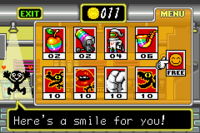
The smile is a reference to the Japanese McDonald's menu, in which the charge of a smile is ¥0.
Donkey Kong Country series[edit]
Donkey Kong Country[edit]
- In the Game Boy Advance version of Donkey Kong Country, Sabrewulf from Rare's Killer Instinct fighting game series is stuffed and mounted in Cranky's Cabin, but it is still alive as he occasionally blinks.
Donkey Kong Country 2: Diddy's Kong Quest[edit]
- Dixie Kong's hat features a Rare logo pin on it. This stayed with her until 2002, after the company was bought out by Microsoft.
- Chief Thunder, a character from Killer Instinct, makes a cameo on a poster found in Cranky's Monkey Museum. Also within the museum is a Killer Instinct arcade cabinet.
- After the player has beaten the game, they can take part in Cranky's Video Game Heroes competition. The competition is simply whichever video game hero can collect the most DK Coins. When the player first sees this competition the heroes already present are Mario, Yoshi and Link. A garbage can can also be seen in the bottom corner of the screen next to Sonic the Hedgehog's shoes and Earthworm Jim's raygun, with a sign saying "No hopers" on the can, a jab at Sega. These were removed in the Game Boy Advance version, which was released after that company's rivalry with Nintendo ended.
- The music for the swamp levels has a part that sounds similar to Phil Collins's "In the Air Tonight". The composer for the game, David Wise, confirmed that the similarity was intentional.[26]
Donkey Kong Country 3: Dixie Kong's Double Trouble![edit]
- When talking to Bazaar and asking about the owner of the castle in the Northern Kremisphere, refusing his offer to tell for two coins has him say that Link also came in "just last week" and asked about the castle as well. Bazaar also mentions that when he left he was muttering about his shell being the wrong shape, a reference to the Secret Seashell sidequest in The Legend of Zelda: Link's Awakening. These references were removed from the Game Boy Advance port.
- In the French release, Baron K. Roolenstein asks during the first fight against him if Dixie Kong and Kiddie Kong are familiar with KREM le Survivant, a riff on the 1983 manga Fist of the North Star (titled Ken le Survivant in the French localization of its 1984 anime adaptation).[27]
- When KAOS is destroyed in the final battle and Baron K. Roolenstein appears, one of his quotes is: "[...] and I'd have gotten away with it... ...if it wasn't for you meddling kids." This is a reference to a quote from the Scooby Doo franchise, which is uttered by the criminal after they are unmasked before being taken away by the police.
Donkey Kong Country Returns / Donkey Kong Country Returns 3D[edit]
- At the start of the level Tippy Shippy, fossils resembling Parasites from Metroid Prime appear.
- At one point in the level Foggy Fumes a Mr. Game & Watch-style figure can be seen hammering at a pipe in the background.
- Similarly, what appears to be the skull of Crocomire from Super Metroid can be found.
- In Cranky Kong's Shop in the remake, if the player keeps the Portable DK Barrel selected for a while, Cranky makes a reference to The Legend of Zelda, saying, "It's dangerous to go alone. Buy this!"
Donkey Kong Country: Tropical Freeze[edit]
- In the level Busted Bayou, in the area where the "K" can be found, the player can find Samus Aran's gunship sitting on some tree branches similar to the plane wreckage.
- In the level Amiss Abyss, if the player passes the first signpost and giant illuminating statue, reaches the end of the trench and heads back towards the statue through the anemone (the player must have more than one hit point to do this), a Metroid can be seen floating in the background.
- When hovering over the Crash Guard in Funky's shop, he says, "Vehicle trouble? It's dangerous to go alone--take one of these!", a reference to The Legend of Zelda.
- Donkey Kong can be seen playing a Nintendo 3DS during his idle animation; in addition to two Mario games and his own Donkey Kong Country Returns 3D, one of the games he can be heard playing during this is Animal Crossing: New Leaf.
Donkey Kong Land series[edit]
Donkey Kong Land[edit]
- The name of the nautilus enemy Nemo is a reference to Captain Nemo from the book Twenty Thousand Leagues Under the Sea, with the submarine he pilots being known as the Nautilus.
Donkey Kong Land III[edit]
- Tin Can Valley is named after the American songwriter community Tin Pan Alley.
- The level Miller Instinct is a pun on the Rareware-developed game Killer Instinct.
BS Super Mario Collection[edit]
- Music choices for the game include "The Power of Love" by Huey Lewis and the News, "Never Gonna Give You Up" by Rick Astley, "Danger Zone" by Kenny Loggins, and "The NeverEnding Story".[28]
Shitamachi Ninjō Gekijō[edit]
- In the Windows 95 episode, Bill Gates is portrayed by a Bakabon plush.
Hotel Mario[edit]
- The names of the hotels owned by the Koopalings and Bowser are puns on actual famous hotel and resort brands:
- Morton's Wood Door Hysteria Hotel - Waldorf Astoria
- Roy's HardBrick Hotel - "Heartbreak Hotel" (an Elvis Presley song about a fictional hotel)
- Larry's Chillton Hotel - Hilton
- Lemmy's High-ate Regency Hotel - Hyatt Regency
- Ludwig's Thump Castle Hotel - Trump Towers
- Wendy's Blitz Snarlton Hotel - Ritz-Carlton
- Bowser's Seizures Palace Hotel - Caesars Palace
- Some of Mario's lines reference popular culture, such as "We ain't afraid of no Koopas!" (a play on the line "I ain't afraid of no ghost!" from the Ghostbusters theme song) and "Hey, you! Get off-a my cloud!" (from the Rolling Stones song "Get Off of My Cloud").
- The main theme appears to be based on the main theme from the 1933 film Little Women.
Yoshi's Island series[edit]
Super Mario World 2: Yoshi's Island[edit]
- In the French version of the game, Burt the Bashful is called "Gros Belixo", with the latter half of the name being an anagram of Obelix's name from the Asterix series.
- In the German version of the game, Naval Piranha is called "Audrey", referencing the plant from The Little Shop of Horrors.
- The starry background for some levels (such as KEEP MOVING!!!!) is based upon Vincent Van Gogh's The Starry Night.
- The official Player's Guide description of World 5 references Edgar Allan Poe's "The Raven".[citation needed]
- The North American commercial seemingly references Mr. Creosote's death from Monty Python's The Meaning of Life, especially in the original uncut version of the commercial.
Yoshi's Island DS[edit]
- When Kamek is introducing Hector the Reflector to Yoshi, he says "Mirror, mirror on the wall, I've got a friend who's the ghastliest of them all! Are you frightened yet, little Yoshi?" This references a quote from multiple incarnations of Snow White, specifically the quote uttered by the Evil Queen each time she addresses her sentient mirror.
Yoshi's Story[edit]
- In Jelly Pipe and Torrential Maze, the names "Zelda" and "Pikachu" appear in the newspaper in the background.
Yoshi Topsy-Turvy[edit]
- The Japanese logo of the game incorporates a downwards arrow with a falling apple, referencing the incident that supposedly inspired Isaac Newton's theory of gravity, illustrating its original title "Yoshi's Universal Gravitation".
Yoshi's Woolly World[edit]
- The music played in Yoshi and Cookies has a few tunes from Flower Fields, a level in Kirby's Epic Yarn, which was also developed by Good-Feel and composed by Tomoya Tomita.
- This game reuses sound effects from Kirby's Epic Yarn, which also reused sound effects from Wario Land: Shake It!
- Beads are based on the item with the same name in Kirby's Epic Yarn.
Diddy Kong Racing / Diddy Kong Racing DS[edit]
- Banjo and Conker were included in the original playable roster as "sneak previews" for their then-upcoming games Banjo-Kazooie and Twelve Tales: Conker 64 (which would later be reworked into Conker's Bad Fur Day).
- In the original Diddy Kong Racing, Timber's hat has the Rareware logo on it. This was replaced with the Nintendo DS logo in the remake.
- In Diddy Kong Racing DS, Dixie Kong's hat shows a silver Rareware logo on it, but only when an event happens while racing that she is shown through a box.
Super Smash Bros. series[edit]
- The Beam Sword bears a strong resemblance to the lightsabers of the Star Wars franchise. The sword uses sound effects taken from the Star Wars films in all regional releases of all installments except Super Smash Bros. and Super Smash Bros. Melee, which use such sound effects in their Japanese releases only.
- Samus's green alternate costume that appears in every game in the series is referred to by Masahiro Sakurai on the Japanese Super Smash Bros. website as "mass-produced Samus", a reference to the Gundam franchise.
- Sakurai considers the dual blades that Pit uses in Super Smash Bros. Brawl similar to Darth Maul's double-bladed lightsaber from Star Wars Episode I: The Phantom Menace, as well as the television series The Clone Wars. He also revealed himself to be a fan of the Star Wars series in an issue of Nintendo Power.
- Galleom being able to convert between vehicular and humanoid forms heavily lends itself to Asian "transforming mecha" series - the most well-known example of which is the Transformers franchise.
Donkey Kong 64[edit]
- Two classic games, Jetpac and Donkey Kong, are included as bonus features in this game.
- In the final boss fight of this game, Nintendo and Rareware, the game's publisher and developer respectively, are announced as the sponsors.
- An earlier version of the game featured a shower stall in Donkey Kong's Treehouse with Banjo and Kazooie on the side.
- The first part of the background music for Creepy Castle is an arrangement of "Dauði Baldrs" by Burzum.
- The background music for Creepy Castle's museum contains a sample of "Toccata and Fugue" by Bach.
Luigi's Mansion series[edit]
Luigi's Mansion[edit]
- The boxart of this game resembles the cover design of the 1990 Christmas movie Home Alone.
- The Poltergust 3000 is a parody of the proton pack from the Ghostbusters franchise.
- If Luigi goes to the door to King Boo's alter before capturing the required amount of Boos, a scene will show King Boo mistaking Luigi for Mario. In the scene, King Boo states that, "I will not give up my favorite decoration, I like Mario just where he is". This is a reference to the film Star Wars Episode VI: Return of the Jedi, in which Jabba the Hutt states, "I will not give up my favorite decoration, I like Captain [Han] Solo just where he is". Han Solo hangs frozen in carbonite on a wall similar to Mario being trapped in King Boo's painting.
- The Game Boy Horror resembles a Game Boy Color.
- Three of the Portrait Ghosts are named for real-life historical persons. Henry and Orville are named for Henry Ford and Orville Wright respectively, and Vincent Van Gore is a parody of Vincent van Gogh. In the Spanish translation, however, the twins are given the names of Pedro and Enrique II of Castile, famous stepbrothers in the royalty of Spain; and Van Gore takes the name of another artist, Pablo Picasso.
Luigi's Mansion: Dark Moon[edit]
- The scene where Luigi inspects his TV in the game's introduction is a reference to a scene from the movie Poltergeist.
- The scene inside the Hollow Tree in Haunted Towers where Luigi looks down the staircase is a reference to both the movie Vertigo and the famous camera effect introduced in it, dolly zoom.
- The scene in Treacherous Mansion where two Strong Greenies bring a suit of armor to life is a reference to Frankenstein.
Luigi's Mansion 3[edit]
- In the hallway in the theater on the Paranormal Productions floor, framed posters depicting other games by Next Level Games can be seen. Among them are a poster depicting Little Mac from Punch-Out!! in his victory pose with Doc Louis and Mr. Sandman in the background, as well as a poster depicting the soldiers from Metroid Prime: Federation Force facing a large alien framed in shadow. Pulling on the Punch-Out!! poster with the Suction Shot will destroy it, causing a large green boxing glove (similar to those worn by Little Mac) to fly out.
- Little Mac's gloves can also be found on the floor in the Fitness Center's gym, having been worn by a Hammer.
- The music Amadeus Wolfgeist plays on the piano before his boss battle is an arrangement of the title theme from Metroid Prime: Federation Force.
- Some of the movie sets in Paranormal Productions are references to real movies:
- The Horror Set references the 2002 movie The Ring, featuring a long-haired puppet rising from a well in a similar manner to Samara Morgan.
- The Fire Set contains a bike with a Jewel Rausuto wrapped in a blanket in the bike's basket, referencing E.T. the Extra-Terrestrial.
- The Micro Set references the 1957 film The Incredible Shrinking Man, specifically the scene where the protagonist battles a spider.
- The City Set and the battle that takes place in it is a reference to kaiju films such as the Godzilla series and Pacific Rim, the latter of which one of the game's developers stated he was a big fan.[29]
- If the player reveals GumBoo in the Grand Lobby after failing to catch them once, they will say, "Yoo-hoo! I'm GumBoo! You're no match for me, I gua-ran-tee!". "I gua-ran-tee" was the catchphrase of famous Southern American comedian and chef Justin Wilson, who specialized in Cajun-inspired dishes including gumbo, GumBoo's namesake.
- The carpet in the Hall and the Gallery of the Twisted Suites resembles the one from the 1980 film adaptation of the horror novel The Shining, and the flooring underneath references the floor seen in the 1990's cult-classic paranormal live-action TV series Twin Peaks.
- Johnny Deepend's name is possibly a reference to actor Johnny Depp.
WarioWare series[edit]
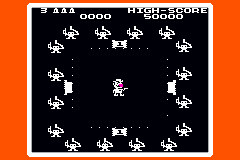
- Many names for microgames in this series are references to famous media and other popular culture.
- Cicada, the second player character in Rhythm Heaven Fever's Kung Fu Ball minigame, has made several appearances in supplementary material relating to Young Cricket, first in his character video for WarioWare Gold and later in some of his artworks in Get It Together!. She would make her first proper appearance in the series in Move It! as the true identity of the muscular penguin that challenges Young Cricket to "micro-combat".
- Lulu's design greatly resembles that of Alice, the protagonist of Balloon Kid, specifically as she appears on the cover of its Japan-only remake. Like Alice, she is also frequently associated with balloons, and an enemy from Balloon Fight appears in her character video for WarioWare Gold.
- In all entries except Game & Wario, 9-Volt and 18-Volt's stages feature microgames that reference classic Nintendo hardware and software, and even games and toys that the company manufactured before going into the video game business. By Smooth Moves, they began to cover more recent games as well as older ones. Also, when 5-Volt became a major character in WarioWare Gold, her game lineup would follow the same theme. The entire list of references can be found here.
- "The Maze That Pays" from WarioWare, Inc.: Mega Microgame$! is a parody of Pac-Man.
- In WarioWare: Twisted!, "Open-And-Shut Case" makes a reference to Little Red Riding Hood, and "Slap Jack" is inspired by Journey to the West in the original Japanese game and Jack and the Beanstalk in localizations.
- In WarioWare: Touched!, Wario's encounter with the Sewer Guru in the opening (in which the guru asks him whether he dropped a pair of Game Boy Advance systems or a Nintendo DS) is a reference to the Aesop's fable The Honest Woodman; and the website's description for Wario-Man makes the analogy that an old garlic clove is to Wario "[w]hat a radioactive spider is to Peter Parker," the alter ego of Spider-Man.
- In Smooth Moves, "Universal Marionette" features a background parodying Leonardo da Vinci's Vitruvian Man, and the White Rabbit from Alice's Adventures in Wonderland is referenced in the victory animation for the first level of "Clock-Watcher."
- Game & Wario features various characters from the Rhythm Heaven games in its cinematics. The Chorus Kids appear with Sal Out in the opening cinematic; the Reporter and Wrestler from Rhythm Heaven Fever appear on the sidewalk in the Pirate minigame's intro and have their own slide in the ending credits; and one of the Rhythm Heaven monkeys is hidden in the crowd during the report of the new console. Harry Onion from Rhythm Tengoku appears on a pile of books in Ashley's intro cutscene. One Rhythm Heaven character, The Wandering Samurai, even gets his own microgame in Gamer. Also in Gamer, the second level of "Sole Man" takes place in a wrecked city on fire where Wario-Man must avoid a giant dinosaur foot, in reference to Godzilla.
- Further allusions to the Rhythm Heaven series are made in WarioWare Gold: Mona imagines a plushie modeled after Tibby, one of the primary characters of Rhythm Heaven Megamix, Mr. Sparkles' rank A character card states he "goes to a gym known for its celebrities, like that wrestler who gets interviewed all the time.", 9-Volt's book contains pictures of the Huebirds of Happiness and dialing the code "CAFE" in the telephone room will lead to a call where someone implied to be the Barista mentions that putting an Ashley doll in his café lead to an influx of new customers, referencing how an Ashley doll is seen in the Café's background in Rhythm Heaven Megamix.
- In WarioWare: Get It Together, level 3 of Pop-Up Patrol features a modified version of the "You Are An Idiot" Trojan horse as one of the pop-up windows that can appear. Plushes of Tibby and Harry Onion also appear in Mona's intro cutscene, and the Barista and Cicada can be seen in certain characters' artworks.
- In WarioWare: Move It!, the Chorus Kids from can be seen on the television during the game's introduction, and the Reporter and Wrestler from Rhythm Heaven Fever can be seen in the audience during the intro for Dribble and Spitz's stage.'
- In WarioWare: Get It Together!, the microgame "Nightmare Fuel" is named after the trope term used to refer to frightening scenes and events in media, which originated from the Mystery Science Theater 3000 episode covering the 1959 film Santa Claus.
- One of the falling objects that appear in the staff credits for WarioWare: Touched! is the Triforce from the Legend of Zelda series. The Triforce also appears as one of the possible drawings in "On the Mark," a WarioWare Gold microgame which had previously appeared in Touched! as "Chalk Full."
Wario World[edit]
- Several Nintendo consoles appear as treasures, including the Nintendo Entertainment System, Game Boy Advance, Nintendo 64 and Nintendo GameCube.
Donkey Konga series[edit]
- Main article: Donkey Konga § List of songs
- Main article: Donkey Konga 2 § List of songs
- Main article: Donkey Konga 3 JP § List of songs
The Donkey Konga series includes both songs from popular culture and music from other Nintendo franchises. The songs are different in each region.
Mario Superstar Baseball[edit]
- During the intro sequence, Mario points his bat towards deep left field before hitting a home run in that direction, referencing Babe Ruth's called shot that was aimed at deep center field.
- During the closing cinematic, which plays after completing Challenge Mode via Special Cup, Mario exits a cornfield to a baseball field in the middle of it, referencing the setting from the 1989 film Field of Dreams.
Mario + Rabbids series[edit]
Mario + Rabbids Kingdom Battle[edit]
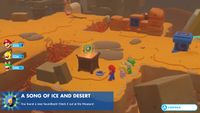
- The title screen theme takes a few tunes from Tribalstack Tropics in Yooka-Laylee, as both games were composed by Grant Kirkhope.
- The soundtrack that plays during the sandy portions of Sherbet Desert is titled "A Song of Ice and Desert", in reference to George R. R. Martin's fantasy novel series, A Song of Ice and Fire.
- The beginning of one of the battle themes, titled "Cold Start, Hot Finish", borrows a riff from the Freezeezy Peak theme from Banjo-Kazooie. Both games' soundtracks were composed by Grant Kirkhope.
- Spawny's visor is designed after the giant robots that inhabit the titular domain in the 1986 animated film Castle in the Sky.[30]
- The Ziggy enemy is named after Ziggy Stardust, a character and stage persona created by English rock musician David Bowie. The Garden Ziggy variety further references the artist and character by featuring a bright yellow mohawk and lightning bolt designs across each eye, referencing the mullet and makeup worn on the cover photo for Bowie's 1973 album Aladdin Sane (his last album before retiring the Ziggy persona).
- In Spooky Trails, the player can find a Rabbid sleeping on a house-like structure. When observed, Beep-0 will say, "He'll catch the Red Baron one of these days." This references Snoopy from Peanuts, particularly his "Flying Ace" persona.
- In Spooky Trails, Beep-0 says, "Coincidence? I think not," a quote from the 2004 Pixar film The Incredibles.
- When examining the Disco Ball at Sherbet Dessert, Beep-0 says, "'Bwah' is the word. It's got groove, it's got meaning." This comes from the 1978 Frankie Valli song "Grease", the title theme to the film of the same name (itself adapted from the 1971 stage musical).
- After the Icicle Golem's defeat, the Rabbid member of the team plays with it for a moment in a manner similar to the "Alas, poor Yorick" scene from Hamlet, then sets it down for Peach to kick it back into the giant refrigerator.
- When talking to Madame Bwahstrella, Beep-0 says, "We'll let you get back to separating the slack-jawed yokels from the money they saved to buy pickled pigs' feet." "Slack-Jawed Yokel" is another name given to the character Cletus from The Simpsons.
- At the beginning of the battle against the Phantom, Beep-0 describes him as a "greedy songbird", a term from the film Amadeus.
- A scrapped animation for Rabbid Peach is based on the transformation sequence of the title character from the manga and anime Sailor Moon.[31]
- Many of the weapons in the game feature pop-culture references in their names, designs, and descriptions:
- Hell in a Shell is named after the WWE event Hell in a Cell.
- Yellow Submarine is named and modeled after the song by The Beatles. Its description includes a reference to the line "And our friends are all aboard".
- Sons of Bwahnarchy is named after the American TV series Sons of Anarchy.
- The "Wrecking Smasher" artwork resembles Miley Cyrus' Wrecking Ball music video.
- Flannel Phantom's description references a slogan used by The Glad Products Company: "Don't get mad! Get Glad!"
- Rainbow Runner's description references the song "Somewhere Over the Rainbow" from The Wizard of Oz.
- Electron, Renegade, Grid Gavel, and Master Control are all references to the film Tron.
- Run For the Hills' name and description reference The Sound of Music.
- Megalodon 2: Payback's description references the tagline for Jaws 2: "Just when you thought it was safe to get back into the water..."
- Surly Temple is named after the Shirley Temple.
- Big Finish's description references the popular 1986 song "The Final Countdown" by the band Europe.
- Nasty Yella Fella's description references a famous line from the film Scarface: "Say hello to my little friend!"
- Matrix Mashup is named and modeled after the film The Matrix. Its description references an iconic scene where the protagonist must choose between ingesting a red pill or a blue pill.
- Gemcutter's description references the theme song to Jem and the Holograms.
- Hammer Time is named after a lyric from the M.C. Hammer song "U Can't Touch This".
- Bat Out of Heck is named after the Meat Loaf album Bat Out of Hell and its titular song.
- Deadeye Dino's description references a famous line from Jurassic Park: "Your scientists were so preoccupied with whether or not they could, they didn't stop to think if they should."
- Killer Extinct's design and description are a reference to the film Jurassic Park, while its name is a reference to the fighting game Killer Instinct.
- Fatal Frame is named after the Fatal Frame series of horror video games.
- Attack From The Future II's name and description both reference Back to the Future Part II. The sentry's description, "It's back! It's back from the future and believe me, it looks VERY gloomy for you enemies[...]", references the events of the film, as Marty McFly returns from 2015 to a dystopian alternate 1985.
- Iron Curtain's design is based on the Marvel superhero Iron Man. Its description mentions a "wise-cracking computerized A.I.", likely referring to J.A.R.V.I.S..
- Louis Harmstrong is named after famous jazz musician Louis Armstrong. Its description includes a reference to his song "What a Wonderful World".
- The King is named and modeled after Elvis Presley, whose nickname is "The King".
- Von Quackington's description parodies a famous quote from Bram Stoker's Dracula.
- The description for Scubam! mentions a "famous Rabbid explorer" named "Bwahcques Bwahsteau", a reference to real-life marine biologist Jacques Cousteau.
- Sam Kingfisher is named after Sam Fisher, protagonist of the Splinter Cell series also produced by Ubisoft.
- Disco Duck shares its name with a song by Rick Dees, and its description references "Stayin' Alive" and "Super Freak" by the Bee Gees and Rick James, respectively.
Mario + Rabbids Sparks of Hope[edit]
- Pyrogeddon and its fiery cloud may possibly be a reference to Sun Wukong from Journey to the West.
- The mission title "Who Ya Gonna Call?" is a reference to the lyrics to the theme song of the film Ghostbusters.
- Augie seems to be a combination of characters from Greek mythology, like Augeas, Poseidon, and either Hephaestus or Iphicles.
- The Dryad is named after similar mythological beings known as dryads who, like her, are associated with plants.
- Edge is seemingly inspired by Cloud Strife from Final Fantasy VII and Guts from Berserk, with her Blade weapons being inspired by the former's Buster Sword.
- The mission title "Tiny Dancer" is named after the Elton John song of the same name.
- The mission title "Creepy Hollow" is named after the fictional location of Sleepy Hollow, which is famous for being the home of the Headless Horseman.
- The mission title "Over the Hills and Far Away" is named after a lyric from the nursery rhyme Five Little Ducks.
Captain Toad: Treasure Tracker (Nintendo Switch / Nintendo 3DS)[edit]
- In a post made on their social media channels, Nintendo Australia and New Zealand tries to comfort a frightened Captain Toad (shown in an attached video) by telling him that there are no Castlevania stages in Captain Toad: Treasure Tracker.[32][33]
Play Nintendo[edit]
Stargazer[edit]
- The preview description "The fault is not in our stars, but Mario is!" references the novel The Fault in Our Stars whose title, in turn, references William Shakespeare's play Julius Caesar.
The Super Mario Bros. Movie[edit]
- The kart used by Stuart in the Illumination logo is inspired by Gru's vehicles from the Despicable Me franchise, with Gru's emblem located on the kart's side, an exhaust resembling that of Gru's airship and car, and a backrest with a skull similar to Gru's motorcycle from Minions: The Rise of Gru.
- In the dinner scene with Mario and Luigi's family, Uncle Arthur jokingly tells the brothers (in reference to their Super Mario Bros. Plumbing commercial), "They gave them the Oscar for worst actors?", a reference to the Academy Awards.
- In the scene where Mario and the Koopa soldiers are driving on Rainbow Road, the Wilhelm scream can be heard.[34]
References[edit]
- ^ a b c d e f g Klepek, Patrick (December 29, 2015). How A Mario Character Was Named After Motorhead's Lemmy. Kotaku. Retrieved May 30, 2024.
- ^ SeraphmIII (August 1, 2020). Famicom Disk Writer (ディスクライター) HQ. YouTube (Japanese). Retrieved May 30, 2024.
- ^ Play Nintendo (May 14, 2022). Super Mario 3D World + Bowser's Fury – GET THEM GOOMBAS! 💪🍄 | @Play Nintendo (01:04). YouTube. Retrieved May 30, 2024.
- ^ DidYouKnowGaming (January 23, 2021). Mario Kart DS - DidYouKnowGaming Ft. Remix. YouTube (English). Retrieved May 30, 2024.
- ^ Lane, Gavin (June 22, 2023). Random: The Super Mario RPG Switch Remake Clarifies A Couple Of Cameos. Nintendo Life. Retrieved May 30, 2024.
- ^ https://imgur.com/a/qCd2uRk
- ^ Mandelin, Clyde (June 29, 2020). The Pop Culture-Obsessed Monsters in Japanese Super Mario RPG. Legends of Localization (English). Retrieved July 31, 2021.
- ^ Hagues, Alana (November 2, 2023). "Super Mario RPG Is The Most Faithful Remake We've Ever Played". Retrieved May 30, 2024.
- ^ Nintendo Unity (November 16, 2023). Super Mario RPG Remake - All Enemy Thoughts. YouTube. Retrieved November 24, 2023.
- ^ Bob Rork Woolsey Interview. Chrono Compendium (English). Retrieved May 30, 2024.
- ^ Shacknews (November 2, 2023). Super Mario RPG Remake Item Shop Gameplay. YouTube. Retrieved November 2, 2023.
- ^ Paper Mario: Color Splash internal filename (\content\script\btl\enemy\heiho\as_btl_heiho_exorcist.bin.lz)
- ^ Paper Mario: Color Splash internal filename (\content\script\btl\enemy\heiho\as_btl_heiho_matrix.bin.lz)
- ^ Paper Mario: The Origami King internal data. Entries for KNPN in data_npc_model.elf.zst name the animations for the pose ヴィーナスポーズ起きる (Venus pose getting up), ヴィーナスポーズ静止 (Venus pose standing), and ヴィーナスポーズ話し (Venus pose talking).
- ^ MarioBrothBlog (June 1, 2021). Paper Mario: The Origami King contains a running gag where Dustin Hoffman's line "Hey! I'm walkin' here!" from the 1969 film Midnight Cowboy (left) is referenced in various ways. Below are all instances of the reference in the game.. X. Retrieved May 30, 2024.
- ^ Paper Mario: The Origami King internal data. Entries for KNP_Dance in data_npc_model.elf.zst name the animation for the dance スリラー, translating to "Thriller".
- ^ NintendoAUNZ (August 4, 2020). Dang it Bobby! #PaperMario. X. Retrieved July 25, 2024. (Archived August 4, 2020, 05:11:25 UTC via Wayback Machine.)
- ^ NintendoAmerica (June 21, 2024). Mario’s blasting off again...! #PaperMarioTheThousandYearDoor. X. Retrieved June 21, 2024.
- ^ Nintendo of America (November 2, 2024). Nintendo of America's X Account Post X. Retrieved November 2nd, 2024
- ^ Mario (beaten up): "Oui! Vous étiez dans le jeu Super Mario Land... ("Yes! You were in the game Super Mario Land...")
Luigi: "T'es sûr que ce n'était pas Sonic le Hérison? (You're sure that wasn't Sonic the Hedgehog?)"
Sawada; translated by Florent Gorges. Super Mario: Manga Adventures, volume 3, p. 153. - ^ Old80s: Retro Stuff And More (January 15, 2020). Game & Watch: Mario's Cement Factory (Table Top, CM-72) (Another One Bites The Dust) (1983 Nintendo). YouTube (English). Retrieved May 14, 2022. (Archived June 6, 2024, 15:52:33 UTC via Wayback Machine.)
- ^ Old80s: Retro Stuff And More (January 21, 2022). Game & Watch: Mario's Cement Factory (Table Top, CM-72A) (Alternate) (1983 Nintendo). YouTube (English). Retrieved May 14, 2022. (Archived August 10, 2024, 00:46:19 UTC via Wayback Machine.)
- ^ All Nintendo Music (November 18, 2019). GameBoy Gallery Complete Soundtrack. YouTube (English). Retrieved May 14, 2022. (Archived March 30, 2023, 22:47:20 UTC via Wayback Machine.)
- ^ Sly DC (November 19, 2015). Nintendo Mario's Egg Catch Game Watch. YouTube. Retrieved May 30, 2024.
- ^ Sly DC (November 20, 2015). Nintendo Luigi's Hammer Toss Game Watch. YouTube. Retrieved May 30, 2024.
- ^ Wise, David (March 6, 2015). @pantalytron No coincidence. I was trying to get the SNES to sound like the Roland CR78 that Phil Collins used for In the air tonight.. X. Retrieved May 30, 2024.
- ^ Super Mario Wiki (January 13, 2021). Fun fax: The French script of Donkey Kong Country 3 has K. Rool reference Hokuto No Ken (or rather its famously deranged French gag dub Ken le Survivant... mais bon). X. Retrieved May 30, 2024.
- ^ DidYouKnowGaming (December 1, 2018). Obscure Mario Facts - Did You Know Gaming? Ft. Greg. YouTube (English). Retrieved October 4, 2024.
- ^ Nintendo of America (June 11, 2019). Luigi's Mansion 3 Gameplay Pt. 1 - Nintendo Treehouse: Live | E3 2019 (20:34). YouTube (American English). Retrieved May 30, 2024.
- ^ Soliani, Davide (August 26, 2017). Ahahaha great. You just found 1 of the two references 😄😍. X (English). Retrieved May 30, 2024.
- ^ DidYouKnowGaming (December 1, 2018). Obscure Mario Facts - Did You Know Gaming? Feat. Greg. YouTube (English). Retrieved May 30, 2024.
- ^ NintendoAUNZ (August 9, 2018). Don’t worry Captain Toad, there are no Castlevania stages in Captain Toad: Treasure Tracker…. X (Australian English). Retrieved June 15, 2023. (Archived May 18, 2020, 23:17:37 UTC via Wayback Machine.)
- ^ NintendoAUNZ (August 9, 2018). Captain Toad: Treasure Tracker (Nintendo Switch & Nintendo 3DS). Facebook. Retrieved June 15, 2023.
- ^ @JoeMoor01284044 (March 10, 2023). The Super Mario Bros. Movie Got A Brand New TV Spot And Had New Footage. We’re So Close To April 5th!. X. Retrieved March 10, 2023.
| Super Mario in culture | ||
|---|---|---|
| References | By external sources | Advertisements • Film • Internet • Music • Publications • Real life • Television (animated · live-action) • Theater • Video games (Nintendo · third-party) |
| Within Super Mario media | References in the Super Mario franchise • References in The Super Mario Bros. Movie • References to Super Mario Bros. | |
| Other lists | Advertisements • Controversies • Rumors and urban legends • Unofficial media acknowledged by Nintendo | |
